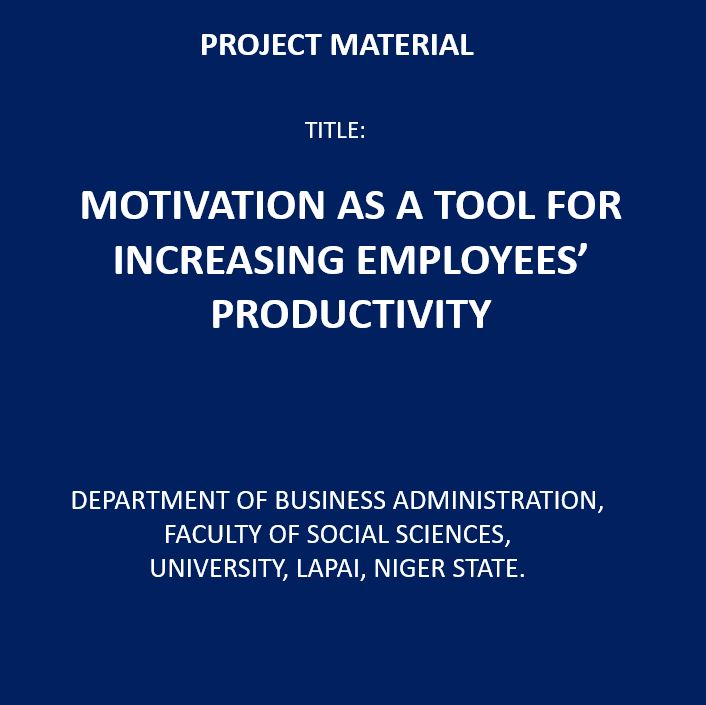No products in the cart.
Motivation as a Too for Increasing Employees’ Productivity
₦3,500.00
MOTIVATION AS A TOOL FOR INCREASING EMPLOYEES’ PRODUCTIVITY
- NUMBER OF PAGES: 60
- FILE TYPE: DOC - CHAPTER 1-5
- DEGREE: BACHELOR
- DEPARTMENT: TT
BACKGROUND OF THE STUDY
Early in the 1950’s when the selling process was at its middle stage; selling process was at its middle age during early 1950’s: most organizations maltreated their employees so harshly and did not consider them as a firm’s assets. This happened as a result of factors like competition, rise of skilled labour and rise of labour unions (Memmott and Growers, 2012; Salanova and Kirmanen, 2010).
The improvement of labour unions and the worsening working conditions in the industrial age, has made it a must for the employers to constantly motivate their employees so as to give them support and encourage their abilities (Evans, 2010).
The significance of motivation even led some well known marketing researchers and scholars to propound and develop some motivation theories such as; Abraham Maslow’s Hierarchical Arrangement of Needs, Hertzberg’s Motivational Factors and Vroom’s Expectancy Theory. All these scholars tried to explain the concept of motivation both from outside and from within the employees themselves (Salanova and Kirmanen, 2010).
The concept of employee motivation is not at all a new idea, as it has been around for a long time due labour relation. While the concept itself is not new, new research and awareness have made new aspects of employee motivation not only a possibility, but a reality in the world today. Recent beliefs and ideas have introduced new concepts to the field of employee motivation (Charles and Marshall, 2012). One of the most common new areas of growth in the area of employee motivation is through the use of work teams. Motivation of employees is one of the important factors that can help to improve both organization and employee performances (Sandhya and Kumar, 2011).
Motivation seems to be one of the most important tools for retaining employees and increases productivity. Organizations design motivation systems are meant to encourage employees to perform in the most effective way but also to attract potential candidates. The key to create the efficient motivation system is an answer to the question what really motivate employees. One of many ways to motivate and retain employees is by giving traditional rewards. The employer cannot and should not wait for the employee to come and ask for a raise or recognition, the employer should be the one to recognize employee’s performance and should reward good performance with monetary, benefits and compensation incentives (Memmott and Growers, 2012).
A good employer should know how to attract and retain his employees (Alkandari, 2009). There might be many other strategies to keep the employees comfortable in the present job but motivation strategies boost the employees on day to day basis. Contrary to modern belief, monetary compensation is not the highest employee motivator. According to the Cruceru and Mihaela (2009), nine out of ten managers think people stay or go because of money. Open communication tends to keep employees informed on key issues. Most importantly, they need to know that their opinions matter and that management is 100 percent interested in their input. Employee Reward Programs as positive recognition for work boosts the motivational levels of employees. Recognition can be made explicit by providing awards like best employee of the month or punctuality award. Project based recognition also has great significance. The award can be in terms of gifts or money (Sandhya and Kumar, 2011).
Motivation factors can be arranged in a hierarchical manner with lower level needs being a prerequisite of higher order needs. The bottom tier consists of physiological needs, food and shelter. After an individual has accomplished gratification of the physiological needs, the next tier progresses to needs consisting of safety and security, needs for love, affection, and belongingness exist in the tier above safety and security, then begins to start higher level needs as the two bottom tiers were physical needs. The next tier above social needs consists of ego and esteem needs. After these needs are met the final tier consists of the need for self actualization, to be completely developed as a person (Johnson, 2007). According to Maslow, self-actualization or ego needs can never be fully satisfied (Tesone, 2005).
No product has been found!
